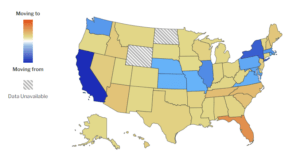As of March 2021, about two-thirds of homeowners who signed up for some type of mortgage forbearance during the Covid-19 pandemic have exited the programs, according to new research from the New York Federal Reserve. Only 35% of borrowers, or about 2.2 million homeowners, who signed up for forbearance remain in these programs, the New York Fed found.
But those who remain in forbearance typically have lower credit scores and live in lower-income neighborhoods, making them more susceptible to losing their homes when these programs end later this year.
“The borrowers in the subprime credit score buckets are much, much more likely to have both entered forbearance, and still be in forbearance at this point,” says Joelle Scally, a financial and economic analyst with the New York Fed and an author of Wednesday’s report.
In contrast, homeowners with the highest credit scores have typically already exited forbearance.
Many of the current forbearance programs were set up in the CARES Act last year and apply to federally-backed loans offered through agencies including Fannie Mae, Freddie Mac, the Federal Housing Administration and the Department of Housing and Urban Development. Private lenders and servicers also set up their own forbearance programs.
The report found that those who have FHA-backed mortgages were more prone to enter forbearance. That’s because these mortgages are typically held by first-time homebuyers who live in lower-income areas.
About 70% of all homeowners still in forbearance are not making any payments, and the worst-case scenario, the researchers estimate, is that about 2.9% of all mortgage borrowers could end up in delinquency. That means the serious delinquency rate, which is defined as payments that are over 90 days late, would shoot up from 0.9% currently to 3.8%.
That’s still much lower than the 6.3% delinquency rate seen in 2010 in the midst of the Great Recession.
But “even if we don’t see levels of delinquency that rival those of the Great Recession, that still could represent a significant amount of hardship for the households involved and it would still be a relatively sharp increase in where we are today,” says Andrew Haughwout, one of the report’s author and senior vice president in the New York Fed’s research and statistics group.
The good news is, this will perhaps not be the “wave” of foreclosures that some experts predicted would occur this fall, once these forbearance programs start to wind down.
In fact, to prevent an overwhelming surge in Americans losing their homes, the Consumer Financial Protection proposed a rule earlier this year that would prevent lenders from starting foreclosure proceedings until 2022. The CFPB’s proposed rule would cover all homeowners, including those with mortgages through private lenders such as banks.
The CFPB’s plan, however, is only a proposal at the moment. The agency was seeking public comments through May 11 before issuing a final rule.
Megan Leonhardt- CNBC






